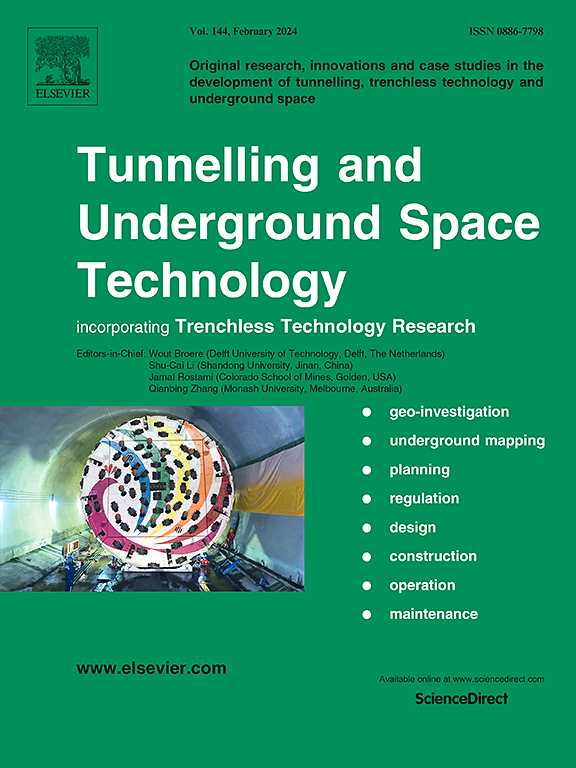Advancing spatial-temporal rock fracture prediction with virtual camera-based data augmentation
IF 6.7
1区 工程技术
Q1 CONSTRUCTION & BUILDING TECHNOLOGY
引用次数: 0
Abstract
Predicting rock fractures in unexcavated areas is a critical yet challenging aspect of geotechnical projects. This task involves forecasting the fracture mapping sequences for unexcavated rock faces using the sequences from excavated ones, which is well-suited for spatial–temporal deep learning techniques. Fracture mapping sequences for deep learning model training can be achieved based on field photography. However, the main obstacle lies in the insufficient availability of high-quality photos. Existing data augmentation techniques rely on slices taken from Discrete Fracture Network (DFN) models. However, slices differ significantly from actual photos taken from the field. To overcome this limitation, this study introduces a new framework that uses Virtual Camera Technology (VCT) to generate “virtual photos” from DFN models. The external (e.g., camera location, direction) and internal parameters (e.g., focal length, resolution, sensor size) of cameras can be considered in this method. The “virtual photos” generated from the VCT and conventional slicing method have been extensively compared. The framework is designed to adapt to any distribution of field fractures and camera settings, serving as a universal tool for practical applications. The whole framework has been packaged as an open-source tool for rock “photos” generation. An open-source benchmark database has also been established based on this tool. To validate the framework’s feasibility, the Predictive Recurrent Neural Network (PredRNN) method is applied to the generated database. A high degree of similarity is observed between the predicted mapping sequences and the ground truth. The model successfully captured the dynamic changes in fracture patterns across different sections, thereby confirming the framework’s practical utility. The source code and dataset can be freely downloaded from GitHub repository (https://github.com/GEO-ATLAS/Rock-Camera).
基于虚拟摄像机的数据增强技术推进岩石断裂时空预测
预测未开挖区域的岩石裂缝是岩土工程中一个关键而又具有挑战性的方面。该任务涉及利用已开挖岩面序列预测未开挖岩面的裂缝映射序列,这非常适合于时空深度学习技术。用于深度学习模型训练的裂缝映射序列可以基于现场摄影实现。然而,主要障碍在于高质量照片的可用性不足。现有的数据增强技术依赖于从离散裂缝网络(DFN)模型中获取的切片。然而,切片与实地拍摄的实际照片有很大不同。为了克服这一限制,本研究引入了一个使用虚拟相机技术(VCT)从DFN模型生成“虚拟照片”的新框架。该方法可以考虑相机的外部参数(如相机位置、方向)和内部参数(如焦距、分辨率、传感器尺寸)。对VCT和传统切片方法生成的“虚拟照片”进行了广泛的比较。该框架设计用于适应任何现场裂缝分布和相机设置,可作为实际应用的通用工具。整个框架被打包成一个用于生成岩石“照片”的开源工具。基于该工具还建立了一个开源基准数据库。为了验证该框架的可行性,将预测递归神经网络(PredRNN)方法应用于生成的数据库。在预测的映射序列和地面真实值之间观察到高度的相似性。该模型成功捕获了不同截面裂缝模式的动态变化,从而证实了该框架的实用性。源代码和数据集可以从GitHub存储库(https://github.com/GEO-ATLAS/Rock-Camera)免费下载。
本文章由计算机程序翻译,如有差异,请以英文原文为准。
求助全文
约1分钟内获得全文
求助全文
来源期刊

Tunnelling and Underground Space Technology
工程技术-工程:土木
CiteScore
11.90
自引率
18.80%
发文量
454
审稿时长
10.8 months
期刊介绍:
Tunnelling and Underground Space Technology is an international journal which publishes authoritative articles encompassing the development of innovative uses of underground space and the results of high quality research into improved, more cost-effective techniques for the planning, geo-investigation, design, construction, operation and maintenance of underground and earth-sheltered structures. The journal provides an effective vehicle for the improved worldwide exchange of information on developments in underground technology - and the experience gained from its use - and is strongly committed to publishing papers on the interdisciplinary aspects of creating, planning, and regulating underground space.
 求助内容:
求助内容: 应助结果提醒方式:
应助结果提醒方式:


